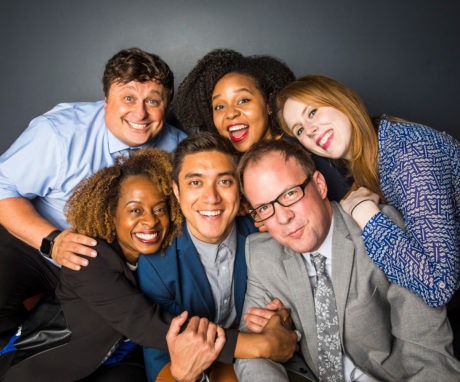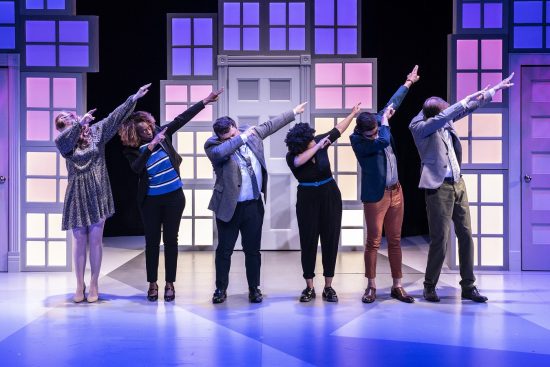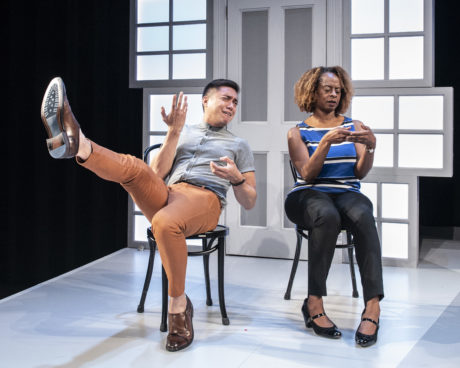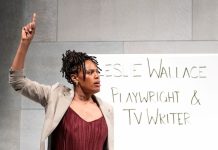Are we brave enough to laugh at ourselves? That’s a question The Second City explores in it’s latest comedy show Generation Gap, playing now through August 12th at the Kennedy Center. The show blends sketch and improv into an exploration of intergenerational relationships that’s a wild and unpredictable roller-coaster ride. Once on board, you have no choice but to lean into the moment and enjoy the hilarity that ensues.

Generation Gap, created by Asia Martin and directed by Anthony LeBlanc, pokes fun at everyone from Baby Boomers to Generation Z, offering a satiric yet well-balanced depiction of various generations and their particular foibles. The ensemble cast employs a wide range of comedic devices, including social and political satire, to unravel the fear and awkwardness that comes with building relationships. Embedded within each free-flowing scene is a kernel of insight about the ways our interactions between generations have evolved. What they’ve created is by no means a passive experience. Attending this show means you’ll likely be called upon to engage with the performers and test your intergenerational knowledge.

Prior to seeing the show, I had a chance to interview ensemble member Cody Dove and participate in a Kennedy Center workshop he facilitated on generating character. Dove is one of the show’s standout performers and a veteran member of The Second City, with numerous TV and radio credits to his name.
When I asked Dove what he wanted the audience to take away from the show, his response was: “A stronger sense of our shared humanity and interconnectedness.” Indeed, as a card-carrying Millennial, Generation Gap reminded me that when it comes to generations, more connects us than separates us.
So here are my three big takeaways, insights from my day of bridging the generation gap:
Insight One: Age Labels Shouldn’t Be Boxes
Why do we feel the need to divide ourselves into subgroups, like generations. Why can’t we all just be people? I posed this question to Cody Dove during our conversation and he offered a layered response: “I think much of it has to do with marketing, segmenting your audience so you know how to reach and influence them, but it also helps people understand where they come from as they grow. It’s a way of relating to someone else and finding your ‘shared experience’ squad.”
Generation Gap broaches this topic with aplomb in one of their funniest sketches. A teenager shows his grandmother how to use Twitter. At first, she’s confused and suspicious of the platform. The grandson then explains to her how youth have leveraged social media to spark social movements and contest the policies of unreliable leaders (think gun violence or the Arab Spring). This insight shifts grandma’s mindset and she agrees to join the Twitter-verse. Grandma then posts a couple of deft tweets that instantly go viral, even catching the attention of the Queen herself, Beyonce. Mouth agape, grandson sits back in awe of her mastery of Twitter and instant social popularity.
One of the greatest misconceptions about millennials is that we are all tech-savvy and that the generations predating us, mainly Baby Boomers and Gen Xers, are tech and social media illiterate, which is often not the case at all. This misconception, however, sets up a false dichotomy that perpetuates generational friction. I was glad to see Generation Gap turn this idea on its head, and break the box wide-open on this notion.

Insight Two: The Secrets to Building Meaningful Connections are All Found in the Core Tenets of Improv – or, Why You Should Look People in the Eye.
When I arrived at the Kennedy Center for the character generator class, a multi-generational group of us were escorted down a long corridor, then to an elevator that let us out onto an office floor for the workshop. That entire time, which spanned about five to seven minutes, I don’t think any of us made eye contact with someone we didn’t already know. The elevator ride felt the most awkward. To break the tension, a few people whipped out their phones, perhaps to have a place to direct their focus. Everyone was polite and a few nervous laughs were shared but that was the extent of any connecting. Once the class began, the energy finally relaxed. We spent most of the workshop walking around the space embodying the physical and emotional prompts that Dove gave us. Periodically we stopped to find a scene partner to complete an exercise together.
We practiced different ways to create a character in a scene, tools all improvisers want to have on tap in their arsenals. However, the most transformational gift imparted to us was a seemingly small and inconsequential instruction that Dove mentioned at the top of the class, “make eye contact with each other as you explore the space.” The very thing many of us had unconsciously avoided had now become a central element of our creative journeys. Once we began to lock eyes, the hesitance and timidity that some of us entered with evaporated. We even took it up a notch and added a smile and slight head nod to acknowledge the other person’s presence. The eye contact definitely deepened our connection and comfort levels during our scene work. I left class exhilarated and wanting more, feeling I had really connected with those around me, which is the same way I felt after the show.

Insight Three: There’s Only One World We Need to Change (Our Own)
One of the fundamentals of improv is to view everything someone says and does as a gift. By focusing on supporting your scene partners, you create a story that neither of you could have developed on your own. Imagine the impact if we applied that philosophy to our everyday lives?
How many times do we approach strangers with preconceived notions in mind? How many times do we dismiss someone before really getting to know them because they are too this or too that (but not enough like us)?
Improv teaches us that we are all in this together. That listening to others is vital because it informs your responses – responses that need to be made quickly and humorously. Each scene in improv is a joint search for clarity that can only be found through listening and developing trust and connection. When you approach life as improv artists approach a scene, with the idea that we are all in this together, you inevitably expand your own worldview.
Improv is a world of infinite possibility and the beauty of improv is that we can see our reflection in it. It’s often only one-step removed from reality regardless of how off-the-wall outrageous or far-fetched the story appears. When the actors on stage “endow the characters they play with a soul,” as Cody Dove says, it elevates the story unfolding before our eyes and it speaks to us in a way few other art forms can.
___
So, what’s my ultimate takeaway? Generation Gap reminds me that maybe we’re not so different after all. Maybe if we can find the time to laugh, to look each other in the eye, to appreciate what other people have to say, maybe that would give us the courage we need to laugh at ourselves in the face of life’s challenges just like Generation Gap taps into the hilarity of generations laughing at themselves.




